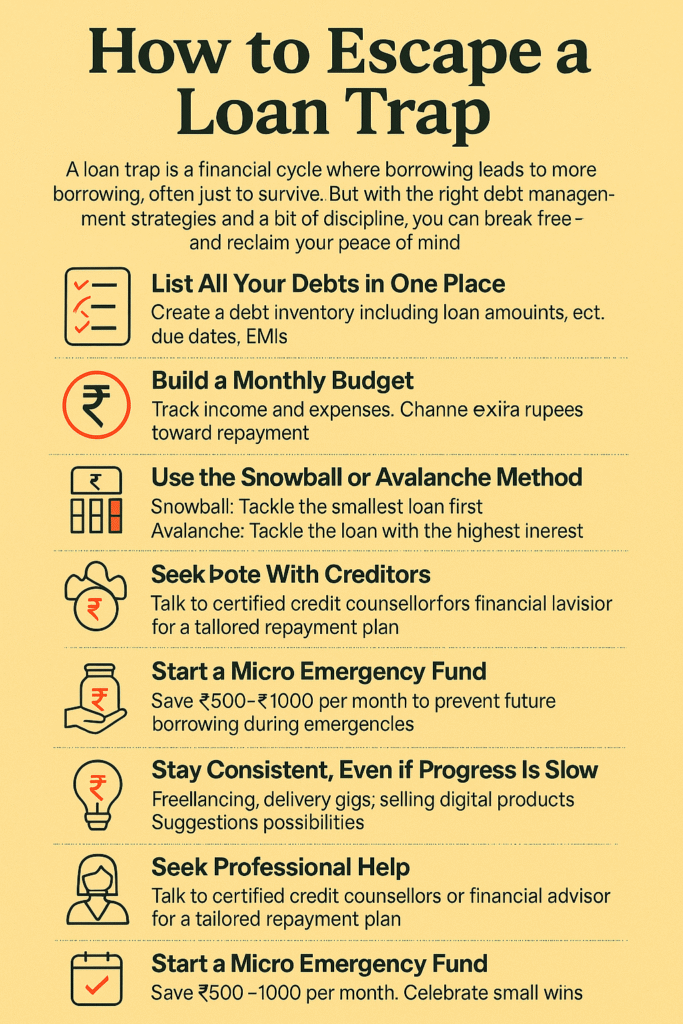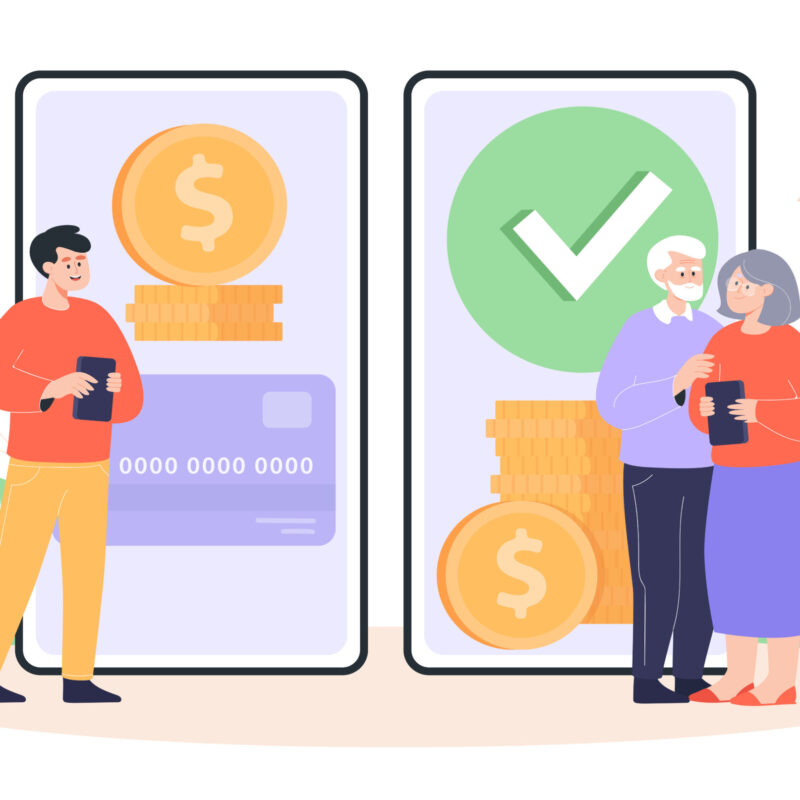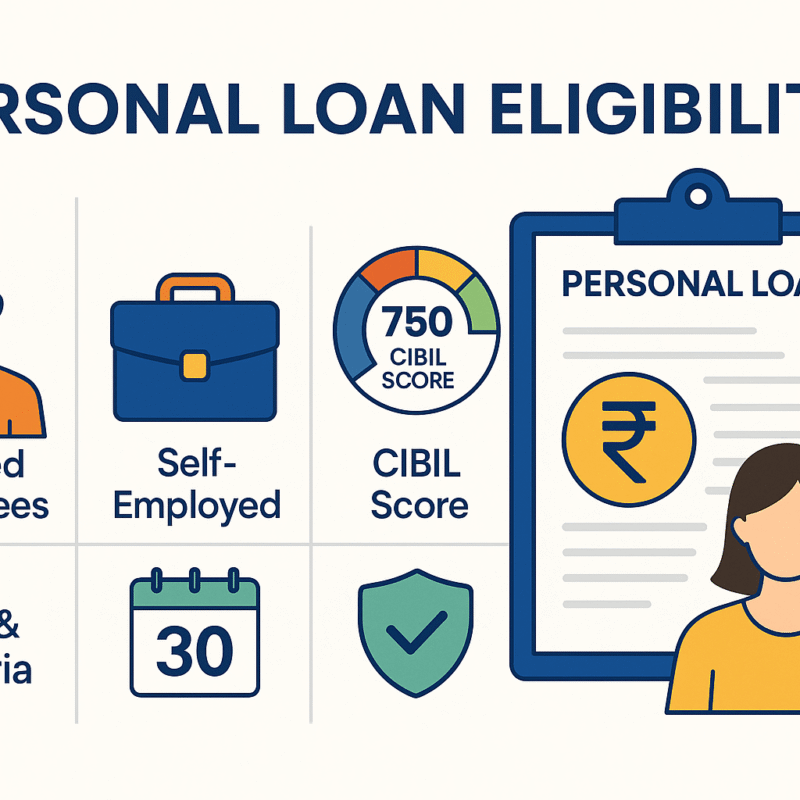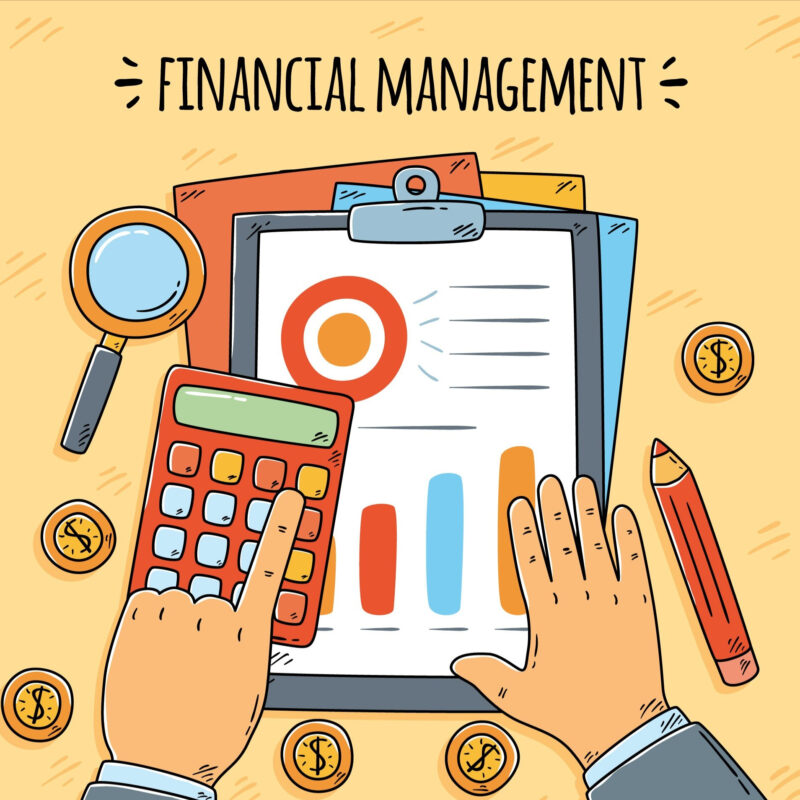In today’s digital-first world, taking a loan has become easier than ordering a meal online. Personal loans, instant credit apps, and credit cards offer fast relief for emergencies, lifestyle upgrades, or big-ticket purchases. But what begins as a helping hand can quickly spiral into a loan trap — a vicious cycle where borrowing leads to more borrowing.
If you’re feeling stuck, buried under EMIs, and unsure how to move forward, this guide will help you understand what a loan trap is and show you practical ways to overcome it and escape for good.

What is a Loan Trap?
A loan trap occurs when you’re forced to take on new loans to repay old ones. Over time, this leads to a never-ending cycle of debt that becomes harder to break. You’re paying interest upon interest, juggling multiple EMIs, and watching your savings dwindle.
Common Causes of Loan Traps:
- High-interest personal loans
- Credit card debt rollovers
- Payday or quick app-based loans
- Loan EMIs exceeding your monthly income
- Lack of emergency savings
These factors build pressure and can cause serious financial and emotional stress. But you can break the cycle with the right strategy.
The Real Cost of Staying in a Loan Trap
Being stuck in a loan trap doesn’t just affect your bank balance. It has long-term consequences on your credit score, mental health, and future borrowing potential.
| Problem | Impact |
|---|---|
| Multiple loans | Harder to track payments, increased chances of default |
| High interest rates | Compounds debt quickly |
| Credit score drops | Affects future eligibility for housing, business, or vehicle loans |
| Missed EMIs | Leads to penalties and legal issues |
| Financial stress | Affects work performance and personal relationships |
10 Proven Ways to Escape and Overcome a Loan Trap
Here are 10 actionable strategies to escape and overcome your loan trap effectively:

1. List All Your Debts Clearly
Write down every loan you have:
- Amount owed
- Lender name
- Interest rate
- EMI amount
- Due dates
This gives you a bird’s eye view and helps you prioritize payments.
2. Stop Borrowing More
Avoid the temptation to take out another loan to repay existing ones. This only digs the hole deeper. Instead, focus on managing what you already owe.
3. Create a Realistic Monthly Budget
Track income and expenses down to the last rupee. Prioritize essentials: rent, groceries, transport. Eliminate or reduce:
- Subscriptions
- Dining out
- Impulse purchases
Allocate the rest to debt repayment.
4. Choose a Repayment Strategy
| Strategy | What It Does | Best For |
|---|---|---|
| Snowball Method | Pays off the smallest loan first | Motivation and momentum |
| Avalanche Method | Pays off the highest-interest loan first | Saving the most money |
Pick one and stick with it.

5. Talk to Your Lenders
Most people don’t realize lenders are open to negotiation. You can:
- Request lower interest
- Ask for EMI restructuring.
- Seek a one-time settlement.
This shows you’re proactive, not evasive.
6. Consider Debt Consolidation
Consolidate multiple loans into a single, low-interest loan. This simplifies repayments and reduces your EMI burden. Only do this through a credible financial institution.
7. Increase Your Income
Explore side hustles:
- Freelancing (writing, design, tutoring)
- Delivery gigs
- Selling pre-owned goods
- Monetizing a hobby (crafts, music, baking)
Use this extra income strictly for debt repayment.
8. Seek Professional Help
Talk to a certified financial advisor or credit counselor. Many non-profit organizations offer free or affordable debt consultation.
9. Start an Emergency Fund
Even Rs. 500–1,000/month can help. This prevents future loans when emergencies strike. Keep it separate from your primary account.
10. Stay Consistent and Patient
There are no overnight fixes. Consistency is key. Every EMI paid is progress. Celebrate small wins.
Alternative Approach: Debt Snowball + Passive Income Strategy
If traditional budgeting and repayment plans feel overwhelming, here’s an alternative solution that combines psychological wins with long-term financial growth:
Step 1: Follow the Debt Snowball for Motivation
The Debt Snowball method is a powerful psychological strategy to overcome a loan trap by building momentum through small wins. Begin by listing all your debts from smallest to largest, regardless of their interest rates. Focus on paying off the smallest debt first while continuing to make minimum payments on the others. Once the smallest debt is cleared, redirect its EMI (monthly payment) to the next smallest loan. This “snowball effect” creates a sense of accomplishment and keeps you motivated as you progress. Over time, each cleared debt increases your repayment power and brings you closer to financial freedom.
Step 2: Automate Micro-Investments
Use micro-investment platforms to invest small amounts (as low as ₹100/week) into mutual funds or ETFs. This creates a habit of saving even while repaying debt.
Step 3: Build Passive Income
Long-term passive income can fund future EMIs or savings:
- Start a blog, YouTube channel, or podcast
- Sell digital products (eBook’s, printables)
- Invest in dividend-paying stocks or REITs
- Rent out a room or vehicle
Step 4: Use Extra Income to Speed Up Repayment
Direct every rupee from passive or side income to repay loans faster. Treat it as a bonus, not spending money.
Step 5: Re-evaluate Monthly
Revisit your strategy monthly. Adjust as income increases or debts reduce. Financial flexibility keeps you in control.
Frequently Asked Questions (FAQ)
Q1: What is the fastest way to escape a loan traps?
There’s no magic bullet, but the combination of debt consolidation, a strict budget, and side income can speed up your recovery.
Q2: Is it bad to take a personal loan?
Not necessarily. Loans used for productive purposes (like education or business) are fine. Problems start when loans are used for consumption or emergencies without a plan to repay.
Q3: Can debt consolidation really help?
Yes, if done right. It reduces EMI burden and simplifies repayment, but only go for it if the interest rate and terms are favorable.
Q4: How long does it take to overcome a loan traps?
Depends on your debt amount and repayment capability. On average, a well-executed plan shows major progress in 6–12 months.
Q5: Will negotiating with my lender affect my credit score?
Not necessarily. As long as you don’t default, restructuring or settlements done with mutual agreement won’t damage your score as much as missed payments.
Q6: Can I invest while repaying debt?
Yes, small automated investments can help build a habit and cushion for emergencies. Just don’t invest more than you can afford while prioritizing debt repayment.
Your Debt Doesn’t Define You
Falling into a loan trap is more common than you think. But staying there? That’s a choice you don’t have to make.
With a clear plan, discipline, and determination, you can escape and overcome any loan traps. Start today with just one small step. Because financial freedom isn’t a dream—it’s a decision.
👉 Read our step-by-step guide to Unlock Online Income: How Selling Credit Cards Can Help You Earn Money
Did this post help you? Share your thoughts or success story in the comments below. Let’s break the debt cycle together.






